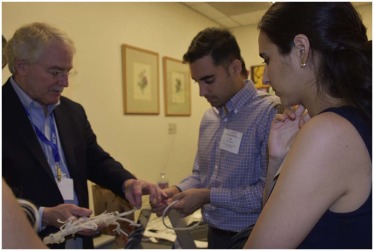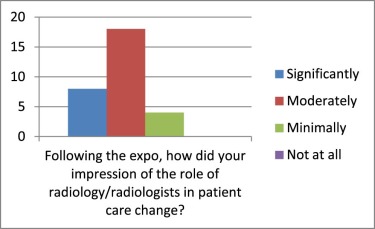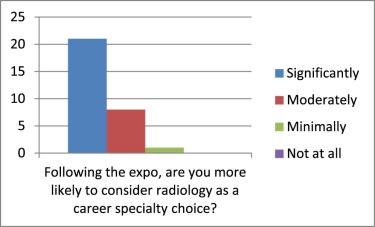Rationale and Objectives
There has been waxing and waning of popularity of radiology as a career choice over the last few years. These fluctuations may in part be due to misconceptions such as the perceived lack of patient contact, as well as the perception of decreasing numbers of entry-level jobs. To address such misconceptions, it is important to reach medical students early in their training, both to give them a comprehensive and balanced understanding of radiology practice, and to appropriately frame radiologists as clinicians. Realizing the benefits of direct student outreach, a number of medical specialties are moving toward more direct recruitment efforts often through student interest groups and career fairs. The Medical Student Radiology Expo (MSRE) was proposed and executed by the Alliance of Medical Students Educators in Radiology, which was supported by the Association of University Radiologists (AUR) and the American College of Radiology. The MSRE was held immediately after the 2016 AUR annual meeting and hosted at the Moores Cancer Center at the University of California, San Diego. The goals of the MSRE were threefold: (1) to showcase radiology as a distinct and exciting specialty to all medical students, (2) to foster an interest in pursuing a career in radiology among medical students, and (3) to create a distributable and customizable combined symposium and workshop that could be easily replicated elsewhere.
Methods
The activities of this 1-day expo started with a morning of didactic elements, including a session identifying inaccurate myths surrounding radiology, specific details of interest pertaining to diagnostic radiology and interventional radiology residency programs, followed by interactive imaging diagnosis games, and question and answer sessions. A casual lunch with faculty members and attendees provided for more sustained direct and informal interactions between the students and the faculty. During the afternoon sessions, students participated in hands-on workshops, including ultrasound, imaging-guided biopsies, catheter manipulation, and post-processing image analysis, as well as roundtable discussions about radiology with the faculty.
Results
The results from the post-program survey of the medical students were overall positive.
Conclusions
The MSRE, with the combined efforts of multiple organizations, was successful. A customizable, modular toolkit has been posted on the AUR website. Using this toolkit as a template, this recruitment and informational activity can be replicated at individual institutions, local radiology chapters, multidisciplinary meetings, and radiology meetings.
Introduction
There has been waxing and waning interest in radiology as a career choice among US medical students in a cyclical manner. There was a sharp decline in interest from 2009 to 2013 , with an uptick in the last 2 years . These fluctuations may be driven in part by misperceptions regarding a long-term slowdown in the job market . With the notion that many radiologists have little patient contact and the less visible role of radiologists on the patient care team, there may also be a misperception that radiologists are not valued or seen as integral members of the patient care teams. According to a recent survey of fourth-year medical students, one of the top reasonsstudents gave for choosing a career other than radiology was the perceived lack of patient interaction .
Reaching medical students early in their training is essential to reinforce the fact that radiologists have direct patient contact and play critical roles in patient care teams . To convey the message to the entire future physician workforce, effective outreach efforts addressing the misperception of radiology and radiologists should broadly target all medical students rather than just those who express an early interest in radiology. It is also essential to capitalize on methods and approaches outside of the existing standard medical school curriculum, such as mentoring by radiologists, participation of medical students in radiology research, radiology student interest group activities, and institutional student fairs . Realizing the benefits of active outreach, a number of other medical specialties have already moved toward more direct recruitment efforts, often through student interest groups and career fairs .
Get Radiology Tree app to read full this article<
Get Radiology Tree app to read full this article<
Get Radiology Tree app to read full this article<
Methods
Get Radiology Tree app to read full this article<
Get Radiology Tree app to read full this article<
Medical Student Radiology Expo (MSRE)
Get Radiology Tree app to read full this article<
Advertisement, Preparation, and Registration
Get Radiology Tree app to read full this article<
Get Radiology Tree app to read full this article<
Get Radiology Tree app to read full this article<
Content of the Expo
Get Radiology Tree app to read full this article<
Get Radiology Tree app to read full this article<
Get Radiology Tree app to read full this article<
Get Radiology Tree app to read full this article<
Get Radiology Tree app to read full this article<
Get Radiology Tree app to read full this article<
Get Radiology Tree app to read full this article<
Results
Get Radiology Tree app to read full this article<
Get Radiology Tree app to read full this article<
Get Radiology Tree app to read full this article<
Get Radiology Tree app to read full this article<
Get Radiology Tree app to read full this article<
Get Radiology Tree app to read full this article<
Get Radiology Tree app to read full this article<
Discussion
Get Radiology Tree app to read full this article<
Get Radiology Tree app to read full this article<
Get Radiology Tree app to read full this article<
Get Radiology Tree app to read full this article<
Conclusion
Get Radiology Tree app to read full this article<
Get Radiology Tree app to read full this article<
Acknowledgments
Get Radiology Tree app to read full this article<
Appendix 1
Radiology Medical Student Expo Outline
Get Radiology Tree app to read full this article<
Get Radiology Tree app to read full this article<
Get Radiology Tree app to read full this article<
Get Radiology Tree app to read full this article<
Get Radiology Tree app to read full this article<
Get Radiology Tree app to read full this article<
Get Radiology Tree app to read full this article<
Get Radiology Tree app to read full this article<
Get Radiology Tree app to read full this article<
Get Radiology Tree app to read full this article<
Get Radiology Tree app to read full this article<
Get Radiology Tree app to read full this article<
Get Radiology Tree app to read full this article<
Appendix 2
Post-Expo Survey
Get Radiology Tree app to read full this article<
Not engaging Neutral Engaging Very engaging Videos Talks Games Panel Mixer Workshops
Get Radiology Tree app to read full this article<
Not informative Neutral Informative Very informative Videos Talks Games Panel Mixer Workshops
Get Radiology Tree app to read full this article<
Get Radiology Tree app to read full this article<
Get Radiology Tree app to read full this article<
Get Radiology Tree app to read full this article<
References
1. Chen J.Y., Heller M.T.: How competitive is the match for radiology residency? Present view and historical perspective. J Am Coll Radiol 2014; 11: pp. 501-506.
2. Chen J.Y.: 2016 Residency match update and the golden opportunity. J Am Coll Radiol 2016; 13: pp. 1242-1243.
3. Rozenstein A.: AUR presentation: 2015 NRMP radiology results. AUR2015.
4. National Resident Matching Program, Results and Data: 2015 Main Residency Match ® . Washington, DC; 2015; pp 4-5, pp 22-23; Available at: http://www.nrmp.org/wp-content/uploads/2015/05/Main-Match-Results-and-Data-2015_final.pdf Accessed March 22, 2017
5. Prabhakar A.M., Oklu R., Harvey H.B., et. al.: The radiology job market: analysis of the ACR jobs board. J Am Coll Radiol 2014; 11: pp. 507-511.
6. Levin D.C., Rao V.M.: The declining radiology job market: how should radiologists respond?. J Am Coll Radiol 2013; 10: pp. 231-233.
7. Allen B.: Myth-busters #2 – job market, MSRE presentation. Available at: http://www.aur.org/medical-student-expo-tool-kit/ Accessed March 22, 2017
8. Dall T.M., Gallo P.D., Chakrabarti R., et. al.: An aging population and growing disease burden will require a large and specialized health care workforce by 2025. Health Aff (Millwood) 2013; 32: pp. 2013-2020.
9. Arleo E.K., Bluth E., Francavilla M., et. al.: Surveying fourth-year medical students regarding the choice of diagnostic radiology as a specialty. J Am Coll Radiol 2016; 13: pp. 188-195.
10. Straus C.M., Webb E.M., Kondo K.L., et. al.: Medical student radiology education: summary and recommendations from a national survey of medical school and radiology department leadership. J Am Coll Radiol 2014; 11: pp. 606-610.
11. McGaha A.L., Garrett E., Jobe A.C., et. al.: Responses to medical students’ frequently asked questions about family medicine. Am Fam Physician 2007; 76: pp. 99-106.
12. White B.: Family medicine attracts more students in 2011 residency match. Posted Mar 18; Available at: http://blogs.aafp.org/fpm/noteworthy/entry/family_medicine_attracts_more_students Accessed March 22, 2017
13. Kattapuram T.M., Sheth R.A., Ganguli S., et. al.: Interventional radiology symposium for medical students: raising awareness, understanding, and interest. J Am Coll Radiol 2015; 12: pp. 968-971.
14. SIR website : How to start a local IR symposium. Available at: http://rfs.sirweb.org/wordpressnstall/medical-student-section/how-to-start-a-local-ir-symposium/ Accessed March 22, 2017
15. Lightfoote J.B., Deville C., Ma L.D., et. al.: Diversity, inclusion, and representation: it is time to act. J Am Coll Radiol 2016; 13: pp. 1421-1425.
16. Anzai Y., Meltzer C.C., DeStigter K.K., et. al.: Entrepreneurial women in radiology: role models of success. J Am Coll Radiol 2016; 13: pp. 1378-1382.
17. Lightfoote J.B., Fielding J.R., Deville C., et. al.: Improving diversity, inclusion, and representation in radiology and radiation oncology part 2: challenges and recommendations. J Am Coll Radiol 2014; 11: pp. 764-770.
18. Association of American Medical Colleges : Applicants and matriculants data. Available at: https://www.aamc.org/data/facts/applicantmatriculant/ Accessed March 22, 2017
19. Eckleberry-Hunt J., Tucciarone J.: The challenges and opportunities of teaching “Generation Y”. J Grad Med Educ 2011; 3: pp. 458-461.
20. Webb E.M., Vella M., Straus C.M., et. al.: Interpretive versus noninterpretive content in top-selling radiology textbooks: what are we teaching medical students?. Acad Radiol 2015; 22: pp. 520-526.
21. Francavilla M., Straus C., Reddy S., et. al.: Surveying academic radiology department chairs regarding new and effective strategies for medical student recruitment. AJR 2016; 207: pp. 1171-1175.
22. Kashiwagi D.T., Varkey P., Cook D.A.: Mentoring programs for physicians in academic medicine: a systematic review. Acad Med 2013; 88: pp. 1029-1037.
23. Rose G.L., Rukstalis M.R., Schuckit M.A.: Informal mentoring between faculty and medical students. Acad Med 2005; 80: pp. 344-348.
24. AAMC : Careers in medicine. Available at: https://www.aamc.org/cim/ Accessed March 22, 2017
25. Sweeney K.R., Fritz R.A., Rodgers S.M.: Careers in medicine at Vanderbilt University School of Medicine: an innovative approach to specialty exploration and selection. Acad Med 2012; 87: pp. 942-948.
26. Brink J.A.: September is radiology expo month. How can you educate medical students about radiology?. Available at: https://acrbulletin.org/acr-bulletin-july-2016/543-expo-september-radiology Accessed March 22, 2017
27. AUR/AMSER : Medical Student Expo Tool Kit. Available at: http://www.aur.org/medical-student-expo-tool-kit/ Accessed March 22, 2017


